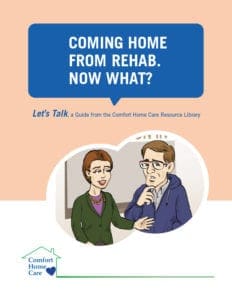
Patients and their families may prefer one level of care over another. Whereas many prefer care in the comfort of their own home, many others feel more comfortable knowing they have close 24/7 support from a nursing staff with inpatient care. The severity of the patient’s symptoms and how often care is needed also play a large role in the most appropriate level of hospice care.
Many patients will transition from one level of care to another as their condition worsens. Other levels of care (namely respite care) are geared more towards offering support for the primary caregiver rather than the hospice patient. The following is a review of each of the four levels of care that providers must offer to patients.
Routine Care
Routine hospice care, also called routine home care or intermittent home care, is the most popular level of care. In fact, according to the National Hospice and Palliative Care Organization (NHPCO), more than 90 percent of hospice care falls within this level. Some patients may spend the entirety of their time in routine care, whereas many others may need to transition into the other levels of care as their symptoms and conditions worsen.
Routine care refers to a series of regularly scheduled visits to help the patient who is dealing with a terminal illness and their family. It may include nursing services for pain relief and symptom management, physical and occupational therapy, social services, at-home medical supplies and health-aide services.
Each routine care plan is tailored specifically for the patient and their family. Hospice providers base each individual plan on the amount of care required and the preference of the patient. Patients can still receive unscheduled visits when necessary. Most hospice care providers have nurses that are available around the clock even for patients who are at the level of routine care.
Continuous Care

For example, a patient may require continuous care if they are dealing with temporary nausea and vomiting. Other examples of times when continuous care may be needed include when pain does not improve through routine hospice care or when panic attacks and other types of severe anxiety occur.
At least 50 percent of the care must be provided by a nursing staff, which can deal with most of the discomforting symptoms of terminal illnesses. If more attention is required, or if the issue is related to a mental health complication that the in-home nursing staff cannot handle alone, then inpatient care may be in order.
Inpatient Care
Often, hospice patients feel more comfortable receiving care in an inpatient care facility. This could be in the form of a hospice care facility, nursing home or another form of assisted living facility. Many other hospice patients may require inpatient care if their acute symptoms are so severe it requires immediate medical attention.
However, most who choose inpatient care have the same needs as those who require continuous care, and the choice is a matter of preference. Inpatient care provides available nurses around the clock within the facility to offer support and care in a variety of ways.
The best way to determine if continuous care or inpatient care is right for you is to discuss both options with your family, primary care physician and the hospice care team. They can help you and your family weigh the pros and cons of each option and make an informed decision about which one is right for you.
Respite Care

The fact is caring for someone with a terminal illness is demanding. When caregivers feel overwhelmed, they can request respite care. This allows the hospice patient to temporarily check into a care facility for five days or less while the caregiver takes a break. There are no limits or restrictions to the reasons a caregiver may request respite care, and many do so to attend an important event (graduation, wedding, etc.), take a short vacation or simply relax at home and rest.
Find the Right Level of Care
The best way to determine which level of hospice care is ideal is to consult with a hospice care team. We understand that making decisions about hospice care is never easy, but the good news is you and your family do not have to make the decision alone. At Comfort Home Care, we are available to discuss care options for you or your loved one and ensure you have access to your preferred method of care and support.
Here at Comfort Home Care, we offer all four levels of care. If you or a loved one is diagnosed with a terminal illness and has been given a life expectancy of six months or less, then give our team a call today. We take pride in helping patients and their families through the end of life, and we assist with physical symptom management, emotional distress and much more.






